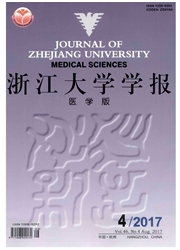

 中文摘要:
中文摘要:
目的:分析接受静脉溶栓治疗的醒后缺血性卒中(WUIS)患者的临床特征及预后,并着重探讨高龄对WUIS静脉溶栓患者临床结局和出血转化的影响。方法:回顾性分析2009年5月至2015年5月期间浙江大学医学院附属第二医院神经内科在多模式影像学检查指导下的重组组织型纤溶酶原激活剂静脉溶栓治疗的WUIS病例资料。出血转化参照ECASSII标准,临床结局评估采用3个月时改良Rankin量表(mRS)评分,mRS≤3分定义为神经功能结局良好。采用单因素及二元logistic回归分析年龄对溶栓后出血转化风险以及神经功能结局的影响。结果:2009年5月至2015年5月共有600例缺血性卒中患者接受静脉溶栓治疗,其中68例为WUIS。单因素分析结果显示:相较于年龄〈80岁的WUIS患者,年龄≥80岁的WUIS患者中男性(41.2%与76.5%,P=0.007)及吸烟者(11.8%与43.1%,P=0.019)比例低,心源性卒中(64.7%与35.3%,P=0.034)比例高,溶栓后出血转化差异无统计学意义,但神经功能良好的比例低(52.9%与78.4%,P=0.043)。以临床结局良好为因变量行二元logistic回归分析发现,高龄不是溶栓后3个月神经功能良好的独立影响因素(OR=0.524,95%CI:0.141-1.953,P=0.336)。以出血转化为因变量行二元logistic回归分析发现。合并心房颤动是WUIS患者溶栓后发生出血转化的独立影响因素(OR=4.947,95%CI:1.194-20.506,P=0.028),而年龄则不是WUIS患者溶栓后发生出血转化的独立影响因素(OR=1.039,95%CI:0.972—1.111,P=0.262)。结论:高龄不增加WUIS患者在多模式影像检查指导下的溶栓后出血转化风险,也不独立影响其神经功能转归。
 英文摘要:
英文摘要:
Objective: To investigate factors related to hemorrhagic transformation and favorable outcomes in wake-up ischemic stroke (WUIS) patients undergoing intravenous thrombolytic therapy. Methods: Clinical data of 600 patients undergoing muhimodal image-guided intravenous recombinant tissue plasminogen activator (rt-PA) therapy in Department of Neurology, the Second Affiliated Hospital, Zhejiang University School of Medicine center from May 2009 to May 2015 were retrospectively analyzed. Among 600 patients, 68 were diagnosed as WUIS including 17 cases aged 80 or older. Hemorrhagic transformation within the first 24 h after thrombolysis was assessed according to ECASS II criteria. Favorable outcome was defined as three-month modified Rankin Scale (mRS) 0-3. Univariate and binary logistic regression were used to analyze the risk factors of hemorrhagic transformation and poor clinical outcomes in WUIS patients. Results: Univariate analysis showed that WUIS patients aged ~〉 80 years had a lower rate in males (41.2% vs 76.5% , P =0. 007) , smokers (11.8% vs 43.1% , P =0.019) and favorable outcome (52.9% vs 78.4% , P =0.043) ; and a higher rate of cardiac embolism (64.7% vs 35.3%, P =0. 034) compared with those aged 〈 80 years. Binary logistic regression showed that age was not an independent risk factor for favorable outcome ( OR = 0. 524, 95% CI: 0. 141 - 1. 953, P = 0. 336) or hemorrhagic transformation ( OR = 1. 039, 95% CI: 0. 972 - 1. 111, P = 0. 262). Conclusion: Older age is not related to the favorable outcome or hemorrhagic transformation in WUIS patients undergoing multimodal image-guided intravenous thrombolytic therapy.
 同期刊论文项目
同期刊论文项目
 同项目期刊论文
同项目期刊论文
 Evaluation of Brain Iron Content Based on Magnetic Resonance Imaging (MRI): Comparison among Phase V
Evaluation of Brain Iron Content Based on Magnetic Resonance Imaging (MRI): Comparison among Phase V Extensive cerebral microbleeds predict parenchymal haemorrhage and poor outcome after intravenous th
Extensive cerebral microbleeds predict parenchymal haemorrhage and poor outcome after intravenous th Rosiglitazone attenuates hyperglycemia-enhanced hemorrhagic transformation after transient focal isc
Rosiglitazone attenuates hyperglycemia-enhanced hemorrhagic transformation after transient focal isc Morphology of susceptibility vessel sign predicts middle cerebral artery recanalization after intrav
Morphology of susceptibility vessel sign predicts middle cerebral artery recanalization after intrav No Hemorrhagic Transformation after Intravenous Thrombolysis in a Pontine Infarction Patient with Ba
No Hemorrhagic Transformation after Intravenous Thrombolysis in a Pontine Infarction Patient with Ba Statin Withdrawal Beyond Acute Phase Affected Outcome of Thrombolytic Stroke Patients An Observation
Statin Withdrawal Beyond Acute Phase Affected Outcome of Thrombolytic Stroke Patients An Observation Different risk factors for poor outcome between patients with positive and negative susceptibility v
Different risk factors for poor outcome between patients with positive and negative susceptibility v 期刊信息
期刊信息
